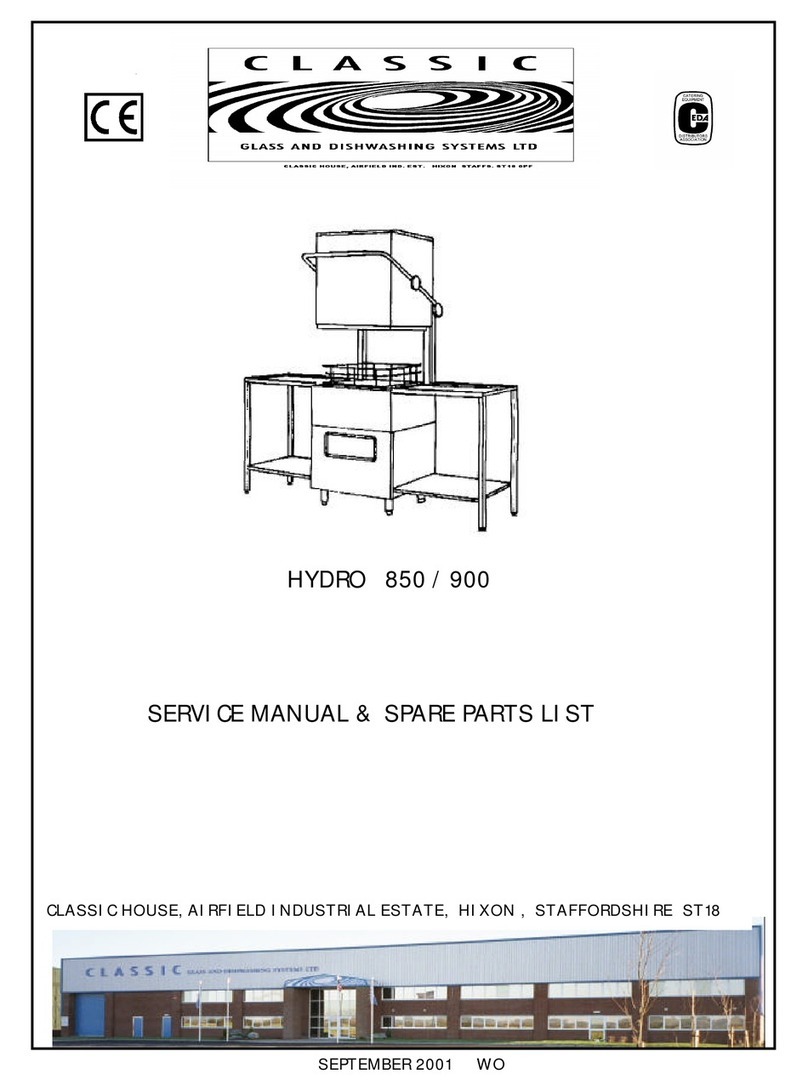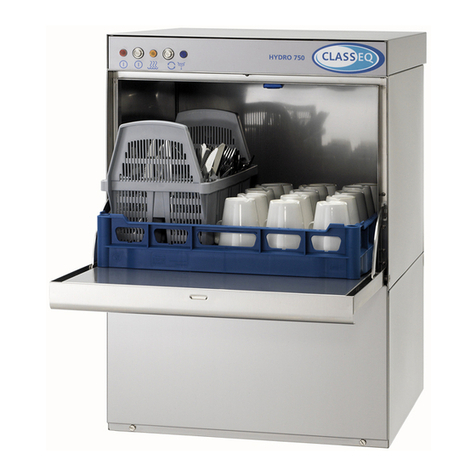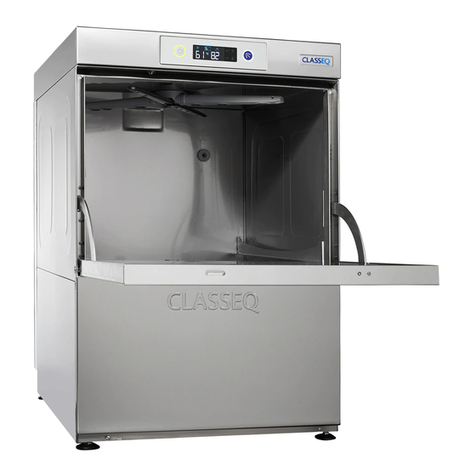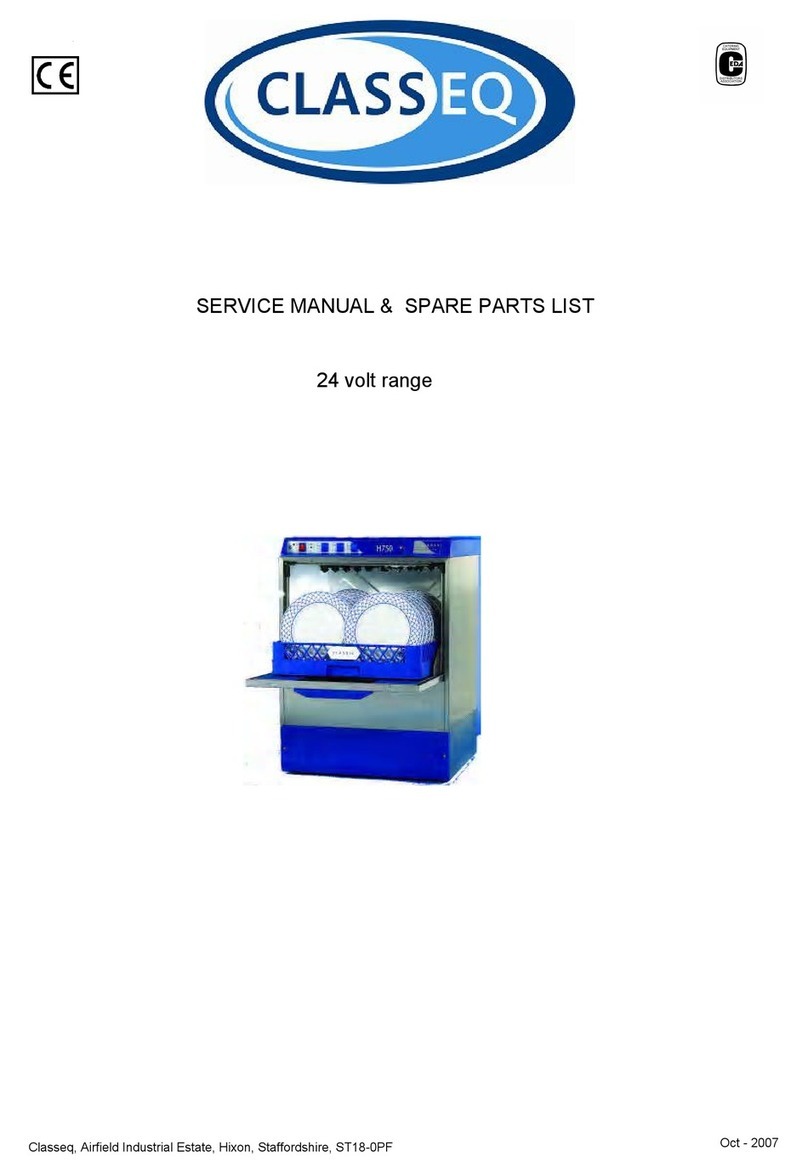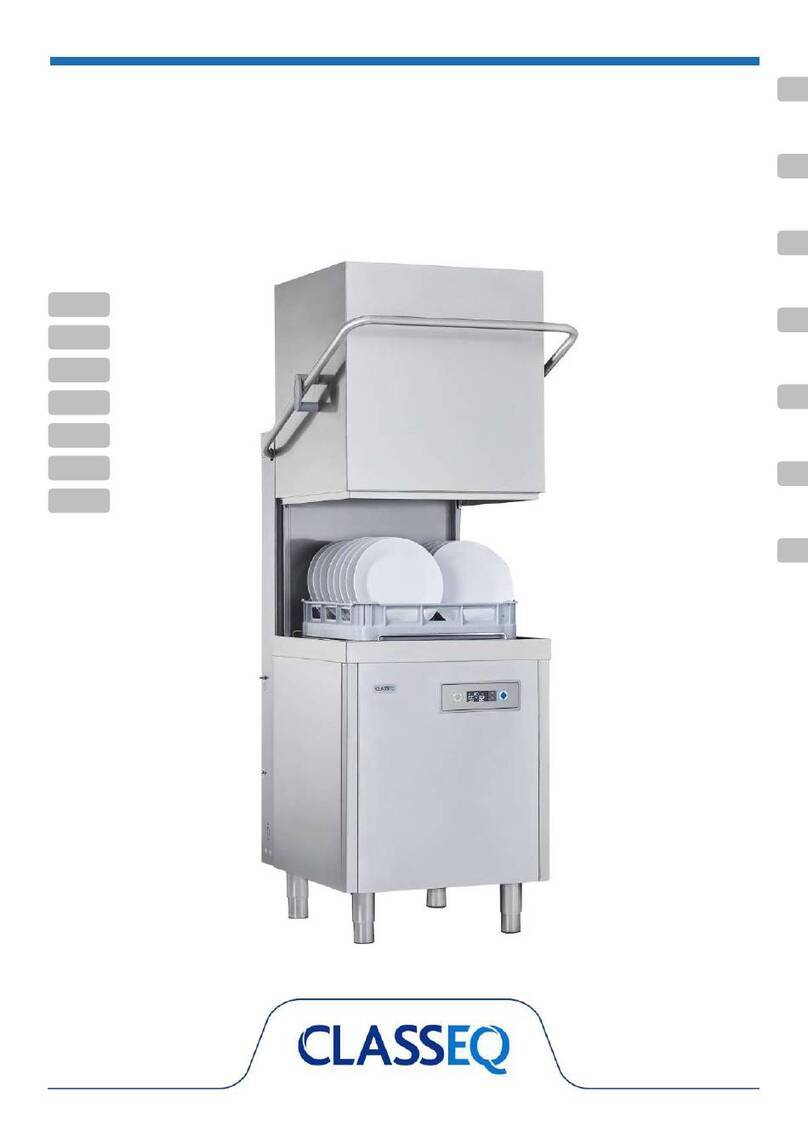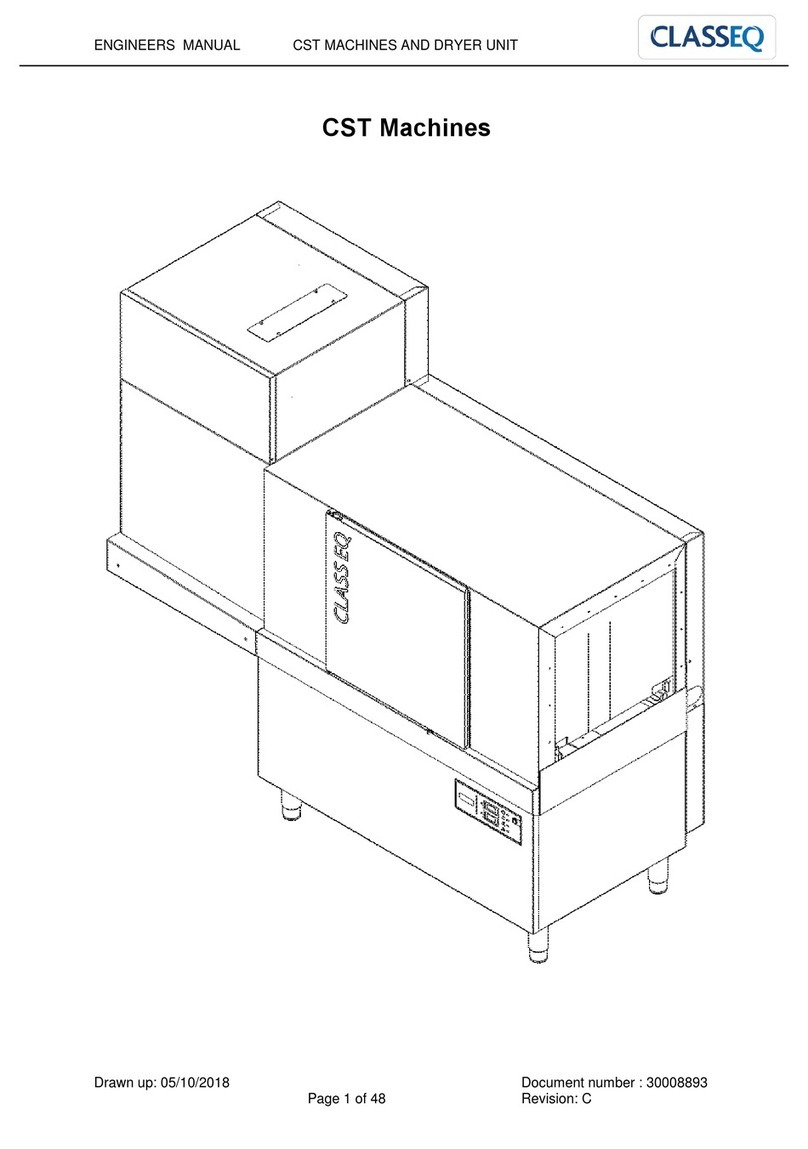Classeq DUO 750 Administrator Guide

Installation & Operators Manual
Installation & Operators Manual
Part number 902.0011
Revision F Jan 2012
Language English
The Classeq Under Counter Range
The Classeq Under Counter Range
Glasswashers
Glasswashers
Dishwasher
Dishwasher
Eco 1
Eco 2
Eco 3
Hydro 400
Hydro 700
Hydro 750
Duo 2
Duo 3
Duo 400
Duo 750
www.classeq.co.uk
Service
℡
0844 2245 245
service@classeq.co.uk
Spares
℡
0844 2245 252
spares@classeq.co.uk
Sales
℡
0844 2245 249
sales@classeq.co.uk

Installation and Operation instructions
Installation and Operation instructions
For under counter range of commercial glass & dishwashers.
Section Title Page(s)
1 Safety instructions
1
2 Your Classeq appliance
2
3 Installation
2 - 5
4 Commissioning
6 - 7
5 Operation
8 - 10
6 Cleaning
11 - 12
8 Decommissioning
15
7 Trouble shooting
12 - 14
TO HELP WHEN CONTACTING PLESE QUOTE THIS
SERIAL NUMBER
Useful Contact Details
www.classeq.co.uk
Service
℡
0844 2245 245
service@classeq.co.uk
Spares
℡
0844 2245 252
spares@classeq.co.uk
Sales
℡
0844 2245 249
sales@classeq.co.uk

CAREFULLY READ THESE INSTRUCTIONS, BEFORE INSTALLING
AND OPERATING THIS APPLIANCE
INCORRECT INSTALLATION, ADAPTATIONS OR ALTERATIONS
COULD RESULT IN INJURY OR DAMAGE TO PROPERTY
MALICIOUS DAMAGE, DAMAGE DUE TO NEGLIGENCE, OR FAILURE
TO COMPLY WITH THESE INSTRUCTIONS AND LOCAL LEGISALTION,
OR UNAUTHORISED TAMPERING WILL INVALIDATE ANY WARRANTY
AND RELIEVE THE MANUFACTURER OF ALL LIABILITY
THE DOOR OF ANY APPLIANCE MUST NEVER BE USED TO STAND
ON
DAMAGE TO THE MACHINE CAUSED DUE TO LIMESCALE WILL NOT
BE COVERED BY THE MANUFACTURES WARRANTY
EACH DAY ALLOW MACHINE TO HEAT BEFORE FIRST WASH CYCLE
CHILDREN SHOULD BE SUPERVISED TO ENSURE THAT THEY DO
NOT PLAY WITH, OR OPERATE THE APPLIANCE
1.0 Safety instructions
1.0 Safety instructions
1.1 Warning :
1.2 Installation :
Installation should only be carried out by a ‘Classeq’ approved technician,
and in accordance with current regulations and within our instructions.
1.3 Modification :
‘Classeq’ reserves the right to modify either the appliance or the contents of
these instructions without notice.
1.4 Operation :
The appliance should only be used by a trained operator as instructed in
section 5 of this manual.
1.5 Failure / malfunction :
In the event of a failure / malfunction, the mains electrical and water supplies
MUST be isolated at the wall and not just at the machine.
1.6 Repairs and spare parts :
The appliance must only be repaired by a ‘Classeq’ approved technician,
using genuine ‘Classeq’ spare parts.
Page 1
Please contact :
Service
℡
0844 2245 245
service@classeq.co.uk
Spares
℡
0844 2245 252
spares@classeq.co.uk

2.0 Your Classeq appliance
2.0 Your Classeq appliance
2.1 Unpacking :
Use suitable means and protective equipment to avoid injury whilst unpacking
and handling the appliance. Remove all outer packaging and the protective
film from the outer panels of the appliance prior to installation.
Ensure all packing materials are disposed of in accordance with local and
national regulations.
2.2 Items included within appliance:
•
2 x Baskets
•
1 x Cutlery basket
(Dishwashers only)
•
1 x Water inlet hose
•
2 x Primary filters
•
2 x Secondary filters
(Only 1 on Gravity drain machines)
•
1 x Drain plug
(Gravity drain machines only)
•
2 x Bottle weights
(for Rinse Aid and Detergent tubes)
•
1 x Installation and Operation Instructions
(Must be left with the customer)
•
1 x Warranty card
(Must be left with the customer)
Page 2
F
E
D
C
B
A
3.0 Installation
3.0 Installation
3.1 The site :
Ensure there is sufficient space for
installation, servicing and easy access
to all mains isolator switches / valves
(i.e. electricity and water). The surface
your appliance will be installed onto
MUST be adequately stable and
capable of supporting the appliance
during normal operation.
Once installed ensure the appliance is
stable, with its weight being distributed
equally and does not tilt more than 3°
in any direction.
Dimensions
(mm)
Eco 2 Eco 3 Duo 2 Duo 3
Eco 1 & Hydro 700 & &
Hydro 400 Hydro 750 Duo 400 Duo 750
Machine ‘A’ = Width 410 450 550 470 570
‘B’ = Depth 510 535 625 535 625
‘C’ = Height (min) 640 740 825 750 835
‘D’ = Width (min) 413 453 553 473 573
‘E’= Depth (min) 530 555 645 545 645
‘F’ = Height (min) 660 760 845 770 855
Machine fully loaded weight 45 kg 61 kg 105 kg 64 kg 110kg
Recess
Operating noise levels <70db <70db <70db <70db <70db

3.3 Electrical connection :
All electrical connections MUST be carried out by an authorised
technician and in accordance with local and national wiring regulations.
As a minimum ‘Classeq’ recommends that the following standards are
maintained :
•
All appliances are connected via a residual current device (R.C.D.)
or earth leakage protection device.
•
EN 60204
Supply isolator switch must have all pole separation of more than 3mm.
•
EN 60335
The appliance must be connected to a equi-potential conductor , the
connection stud is located at the rear of the appliance (a suitable ring
terminal shall be required), this is in addition to the earthed electrical supply.
Prior to connecting the appliance, ensure that the voltage and the supply
fuse complies with the rating plate on the appliance.
If the supply cable is damaged, it must be replaced by a cable or cord
assembly supplied by Classeq, or its service agents, or to the following
minimum specification.
Page 3
4.0mm - Allen key Wire cutters
Electric screw driver (small) Spirit level
Recommended hand tools
3.2 Connections :
All mains connections are made at the rear of
the appliance
G
= Mains electrical supply lead
H
= Earth bonding / Equi-potential stud
J
= Water supply connector (G 3/4”)
K
= Drain / waste water hose
To aid both installation and connection of the appliance, ‘Classeq’
recommends the following hand tools are used.
For electrical rating of appliance refer to rating plate located on appliance
or in this manual.
Machine rating Cable type Temp.
rating
Length
of cable
Conform to
220-240V / 1N~ / 13A PVC 3G 1.5
80°C
minimum
2.75m
IEC 60335-2-58
&
IEC 60227 types 56 & 57
220-240V / 1N~ / 20A PVC 3G 4.0
220-240V / 1N~ / 32A PVC 3G 4.0
380-415V / 3N~ / 13A PVC 5G 2.5
G
H
J
K

3.4 Water connection :
The appliance comes with a water supply hose requiring a G¾” (¾” BSP) male
threaded connection at the mains water supply, upon installation and
commissioning all water joints must be checked for leaks.
New hoses supplied are to be used. Old existing, defective or damaged water
supply hoses are NOT to be used when installing the appliance.
Commercial appliance wash results will be effected by external conditions such
as incoming water temperature, pressure, harness and choice of chemicals.
For the longevity of any water related devices and to ensure you get consistently
good results it is essential your machine is either fed from a soft water supply , or
your Classeq appliance is connected to an appropriate water softener.
IMPORTANT - All supplier warranties are void if lime scale is present within
an appliance.
Page 4
3.3.1 Electrical rating :
Within the ‘Classeq’ range several of the 500mm² basket appliances can
be either down rated or up rated electrically, such a procedure MUST be
carried out by a ‘Classeq’ approved technician.
The down / up rating of the machine is carried out by configuring the
terminal block within the appliance to the following
13 Amp – Single phase
• Links removed between L1, L2 and L3
• Ensure link remains between neutrals (N)
30 Amp – Single phase
• Ensure all link remains between lives
terminals (L1, L2 and L3)
• Ensure link remains between neutrals (N)
Three phase
Only Eco3 and H750 appliances can be converted to three phase, this is performed
by removing electrical links at the terminal between L1 L2 & L3, then installing a new
5 core supply cable, i.e. L1, L2, L3, N and Earth (PE).
FOR ADVISE on water softeners and appropriate chemicals, please contact :
Sales
℡
0844 2245 249
sales@classeq.co.uk

Page 5
If you have any doubts about the drainage system on the machine, please either
contact Classeq or your dealer / agent
3.4.2 Drainage systems
Gravity drain appliances
•
Waste hose must flow down from
the waste outlet to the drain.
•
Ø40mm (1 ½”) standpipe required,
must be lower than the baseline of
the appliance.
•
Joint between standpipe and waste
hose must be water tight.
Pump drain appliances
•
Waste hose can either flow down
from the waste outlet to the drain or
go into a standpipe with a maximum
height of 600mm
•
Ø40mm (1 ½”) standpipe required,
must be no lower than the baseline
of the appliance.
Drain standpipe
600mm
maximum
3.4.1 Water supply restrictions :
Water supply constraints must be adhered to :
•
Incoming water temperature
• 4°c minimum
• 55°c maximum
•
Supply water dynamic pressure
• 0 to 2 bar (0 to 200 kPa) Rinse booster pump required
• 2 to 4 bar (200 to 400 kPa) No modifications required
• 4 to 6 bar (400 to 600 kPa) Flow restrictor required
• 6 bar plus (600 kPa plus) Pressure reducing valve required
If the above requirements are not adhered to, the performance of the appliance
will be impaired
FOR ADVISE on technical enquires, please contact :
Technical support
tech.support@classeq.co.uk
or for Service
℡
0844 2245 245
service@classeq.co.uk

Page 6
4.1.2 Chemical dosage :
Chemical doses are pre-set, however they can be adjustment to suit the
Individual sites requirements, such adjustment is made by turning an adjuster
screw on each chemical pump.
4.1.1 Priming of Rinse aid & Detergent :
This procedure is only required when commissioning the machine and not
in normal operation
•
Ensure the machine is empty of water
•
Switch the water supply OFF
•
Now switch the machine ON at both the mains supply and at the
fascia for 90 seconds only
•
Now switch the machine at the OFF at the fascia
•
Turn the water supply ON
The rinse aide will now be primed, the machine can now be switch ON and
allowed to fill & heat as normal.
4.1 Rinse aid & detergent :
Chemical pump(s) are located behind the front lower panel,
prior to removing any panels all electrical supplies MUST be
isolated. An Allen key is required for this operation.
A coil of PVC hose is attached to each chemical pump, un-
coil PVC hose and feed through either the slots just behind
the chemical pumps, or out through the rear of the base.
After to feeding the PVC hose into the chemical bottle, push
the bottle weight supplied onto the end of each PVC hose.
Ensure the correct chemical tubes now go to the corresponding chemical
bottles. (i.e. rinse aid hose into rinse aid bottle).
WARNING : Only rinse aids and detergents developed for commercial
glass and dishwashers are to be used, rinse aids must be suitable for water
temperatures down to 40°C.
4.0 Commissioning
4.0 Commissioning
For more information, please contact :
Sales
℡
0844 2245 249
sales@classeq.co.uk

Page 7
4.2 Rinse & wash tank temperatures :
The water temperatures on ’Classeq’ range of machines are adjustable, but
have been preset, and should never be adjusted above these temperatures.
Machine type
Temperatures
Rinse water Wash water
Glasswashers 70°c
55°c
Dishwashers 80°c
4.4 Demonstration :
‘Classeq’recommends that prior to leaving the site / installation, the installer
demonstrates the following to the end user, as this will ensure the appliance is
correctly used
•
What to do in case of an emergency, i.e. how to isolate the mains
electricity and water (see section 1).
•
Switching the appliance on.
•
Operating the appliance.
•
Draining down.
•
Switch the appliance off.
•
Clean the appliance, including removal and replacement of all filters.
•
Replenishing and priming of rinse aid and detergent.
Upon completion of the installation and commissioning of the appliance,
this manual MUST be left with the end user.
•
Detergent pump is the left hand pump
•
Rinse aid pump is the right hand pump
Adjustments are made by rotating the adjuster
screw in the front of the pumps
+
Increase dosage, rotate screw clockwise
-
Decrease dosage, rotate screw anticlockwise
Detergent Rinse
aid
1
5
4.1.2 Chemical dosage
(cont)
The chemical pumps are located behind the front lower panel.

Page 8
5.2 Controls :
Prior to switching the machine ON
, ensure that you are familiar with
the controls on the front fascia of the appliance and the location of the
isolator for mains electricity and water supply.
1
1 1
1
ON / OFF lamp
ON / OFF switch
Machine ready lamp
Cycle switch
Cycle lamp
Note !
Appliances fitted with a drain pump, the Cycle switch and lamp double
as the drain down switch and lamp
If in doubt please contact ’Classeq’ for advise.
1
2
3
4
5
5.0 Operation
5.0 Operation
5.1 Machine description :
The design of commercial glass and dishwashing machines differ from
their domestic versions as they are designed to run nearly continually for
many hours.
Please contact Classeq Technical for advice and assistance :
Technical support
tech.support@classeq.co.uk

Page 9
5.3 Switch the machine on :
Ensure that both the water and electrical supply are connected and switched on,
then depress the ‘ON/OFF’ switch located on the fascia of the machine.
The machine will now automatically fill and heat, during this process the door
should remain closed, allowing the process to be completed quickly.
5.4 Machine ready to operate :
It is IMPORTANT after switching the appliance on each day, to allow 25 minutes
before starting the first wash cycle; regardless of the fact that the green Ready
light will already be illuminated.
The appliance is designed to only start a cycle when the correct temperatures
are achieved, so there may be a pause between a cycle being selected and the
cycle starting
5.5 Starting a cycle :
To start a cycle, open the door, load the first basket, ensuring that
bottom and top arms rotate freely.
Close the door, then depress the ‘Cycle’ switch , the cycle will now start once
the appliance has achieved its correct temperatures, during the cycle the ‘Cycle’
lamp will be illuminated.
Once the ‘Cycle’ lamp has gone out (at the end of the cycle)
open the door and remove the basket, then reload the machine and
repeat as required
5.6 Draining :
During normal operation your appliance will automatically drain away any
excess water.
It is very important the machine is drained down at the end of each working
day and the door is left open to allow drying.
The machine should never be left full of water if you are switching the
machine off.

1
2
3
4
5
5.6 Draining (cont.) :
Gravity drain (typically Eco2).
•
Switch appliance OFF at fascia
1
11
1
.
•
Remove drain plug from wash tank.
•
You appliance should now drain under gravity.
•
Once completed replace the drain plug.
•
Now isolate mains water and electricity at the wall.
Drain pump appliances (optional on Eco1,Eco2)
•
Switch appliance OFF at fascia
1
11
1
.
•
Close the door.
•
Now depress the ‘Cycle’ switch , the ’Cycle’ lamp will now
illuminate to indicate that the drain cycle is in progress..
•
Once the ‘Cycle’ lamp goes out, switch the appliance Off at the
wall, DO NOT switch isolate the appliance while in the drain down
cycle.
Note !
Once empty ‘Classeq’ recommends that the mains water and electricity supplies
are isolated at the wall and the machine be cleaned as instructed in section 6 of
this manual
For hygiene reasons it is recommended that once the appliance has
been drained that the door is left open to assist in natural drying of
the wash chamber
Page 10

6.0 Cleaning
6.0 Cleaning
6.1 Prior to cleaning :
Switch off and isolated electrical supply before cleaning the
appliance
WARNING
DO NOT use cleaning agents that contain CHLORINE,
BLEACH or HYPOCHLORITE.
DO NOT use STEEL WOOL, WIRE BRUSHES or any other
abrasive materials.
DO NOT jet wash or hose pipe the appliance down either
internally or on the exterior
6.2 Internal cleaning :
Remove the wash and rinse arms from the appliance,
once removed wash in warm soapy water, ensuring
all debris are removed, before reassembling the arm
Remove all the filters from within the appliance and again wash in warm
soapy water, ensuring all debris are removed.
WARNING
Before cleaning the wash chamber, ensure all sharp items,
such as broken glass or other items which could cause injury
are removed carefully
Now wipe the inside of the wash chamber
ensuring any debris are removed and
the chamber is clean, now reassemble
all filters and wash arms.
Page 11

6.3 Exterior cleaning :
Wipe the exterior of the appliance with a damp sponge
(NOT WET)
Once dry, clean using a STAINLESS STEEL cleaning
agent
7.0 Trouble shooting
7.0 Trouble shooting
•
Before placing a service call , please check the following:
•
Check the appliance is connected to the mains water and electricity
supply and both are turned on.
•
Check levels of chemicals within the rinse aid and detergent bottles.
•
Check the drain / stand pipe is correct for the appliance (refer to
section 3.4.2 of this manual).
NOTE
In the event of a service call being made under Warranty, and it is
found that the fault(s) are due to non-observance of instructions in
this manual, the call will be charged at current rates.
7.1 Appliance does not fill :
Appliance does not start :
Appliance does not rinse :
•
Check water supply is turned ON.
•
Check water supply hose is not trapped or kinked.
•
Check that the appliance is switched ON.
•
Drain appliance fully, then try again to fill the machine, drain as per
instructions 5.6 of this manual..
Page 12
If you wish to purchase stainless steel cleaning agent, please contact :
Spares
℡
0844 2245 252
spares@classeq.co.uk

Page 13
7.2 Appliance fills slowly :
•
Check water supply tap is fully open.
•
Check water supply pressure, should be above 2 bar, if not ask
your dealer to install a booster pump to increase water pressure.
•
Check and clean rinse jets (located on the wash arms within the
appliance).
•
Check water supply hose is not trapped or kinked.
•
Remove any pressure regulator or reducer from the water supply.
7.3 Appliance not heating :
•
Drain appliance fully, then try again to fill the machine, drain as per
instructions 5.6 of this manual..
•
Check the temperature of the mains water, as variations in water
temperature will affect the heating of the appliance.
•
Check that the wash chamber is full of water.
7.4 Appliance not draining :
•
Check and clean all filters within the appliance.
•
Check that the stand pipe / drain is not clogged / blocked.
•
With drain pump appliance, bleed the pump as stated in section
3.4.2. of this manual.
7.5 Poor wash results :
•
Check and replenish chemicals.
•
Check and clean wash and rinse jets on wash arm assembly.
•
Clean filters within appliance and check that they are fitted
correctly.

•
Check water supply is ON and fully open.
•
Rinse dishes of any food debris before placing into the dish-
washer.
•
Glasses may need to be renovated.
•
If glasses are ‘Blooming’ you may need a water softener, call your
dealer to advise on size of water softener required.
•
If a water softener is fitted, replenish the salt within the softener, as
per the water softener instructions.
7.6 Overfilling :
•
Drain appliance fully, then try again to fill the machine, drain as per
instructions 5.6 of this manual.
•
Check and clean all filters within the appliance.
•
Check stand pipe / drain height is configured correctly shown in
section 3.4.2. of this manual
•
Check that the stand pipe / drain is not clogged / blocked.
•
With drain pump appliance, bleed the pump as stated in section
3.4.2. of this manual.
•
If the appliance continues to overfill isolate both the mains
electricity and water, before call a service technician.
7.7 Will not switch ON :
•
On an 13 amp appliance check and replace the fuse in the plug,
ensuring the replacement fuse is of the correct rating.
•
On other amperage appliances check and reset circuit breaker
within the sites fuse board, if the circuit breaker continues to trip
call a service technician immediately.
7.8 Will not switch OFF :
•
Isolate at mains electricity before calling for a service technician
immediately.
Page 14
If you still require service, please contact :
Service
℡
0844 2245 245
service@classeq.co.uk
or for
Technical support
tech.support@classeq.co.uk

8.0 De
8.0 De-
-commissioning
commissioning
If for any reason you require to remove or, de-commission your appliance, then
do so in accordance with local and national regulations. As a minimum
‘Classeq’ recommends the following procedure is followed.
•
Remove chemical tubes from the chemical bottles, ensuring bottles
are then capped to prevent any further spillage; refer to safety
statement on chemical bottles prior to and for dealing with any spillage.
•
Ensure the appliance is fully drained in accordance with section 5.6 of
this manual, once completed remove the waste hose from the drain
standpipe; ensure any spilt liquid is dried prior to advancing to the next
step.
•
Switch off mains electrical supply at wall / isolator / junction box.
•
If the appliance is connected via an electrical plug, disconnect this from
the socket.
•
If the appliance is hardwired into the mains, then this must be
disconnected by a qualified electrician in accordance with local and
national wiring regulations.
•
Once the electrical supply has been disconnected, ensure the
equi-potential / earth bonding wire is removed from the stud at the rear
of the appliance.
•
Turn off the water supply to the machine; and disconnect water supply
hose from mains water supply; ensuring any spillage is dried prior to
moving onto next step.
•
Remove the front lower panel, using an Allen key
•
Now locate the ‘Boiler drainage hose’, as shown,
ensure this protrudes from the front of the appliance,
and you have a container large enough to hold 8
litres of water.
CAUTION If the appliance is being drain
immediately after use, water draining from the
‘Boiler drainage hose’ may be up to 80°c.
•
Loosen the jubilee / hose clip and remove the
stainless steel drain plug, ensuring the water flows
into the container mentioned above. Once fully
drained replace the stainless steel plug and
retighten the jubilee / hose clip.
•
Replace the front panel, and ensure all cables and hoses are secured
to the appliance to prevent tripping hazards. The appliance is now
ready to be removed.
RECYCLING If you are recycling or disposing of your appliance, please
ensure this is done in accordance with local and national regulations.
Boiler drainage
hose
Page 15

Page 16
Glasswasher
range
Dishwasher range
Description & Part number
Eco 1
Eco 2
Duo 2
Eco 3
Duo 3
Hydro 400
Duo 400
Hydro 700
Hydro 750
Duo 750
Drain pump
DP2
Wash pump 0.27kW
522.0001
Wash pump 0.74kW
522.0002
Wash element 2.0kW
555.0001
Rinse element 2.6kW
550.0003
Hydro700 only
Rinse element 6.0kW
550.0001
Hydro & Duo
750 only
Adjustable thermostat
542.0002
Chemical pumps
526.0010
Air pressure switch
530.0001
Air pressure switch
530.0004 (Gravity)
3 pole relay
CONT/30
4 pole contactor
CONTACTOR/4
If you wish to order any of the parts for your Classeq machine please
contact our Spares Parts Department.
A comprehensive parts manual is available on the Classeq website:
www.classeq.co.uk
Spares
℡
0844 2245 252
spares@classeq.co.uk
0870 224 7153

Classeq
Winterhalter House
Roebuck Way
Knowlhill
Milton Keynes
MK5 8WH
Affix
Stamp

Thank you for buying a quality ‘
Classeq
Classeq
Classeq
Classeq
’ product, please complete and post this form without delay
Your new appliance is supplied with a full 12 months
warranty, protecting you against failure due to workmanship
or component failure
The information you supply to ‘Classeq’ is covered by the
DATA PROTECTION ACT. This data will also assist us to
speed up the process, if you require a service visit.
From time to time we may wish to contact you regarding any
future developments, if you do not wish to be contacted please
tick the box .
AFIX
RATING PLATE
HERE
YOUR DETAILS
SITE
ADDRESS
POST CODE
TELEPHONE
PRODUCT DETAILS
DATE OF PURCHASE / INSTALLATION
PURCHASED FROM
CONTACT NAME
POSITION
ARE YOU INTERESTED IN EXTENDED WARRANTIES ?
Please tick the box YES NO
Other manuals for DUO 750
1
This manual suits for next models
9
Table of contents
Other Classeq Dishwasher manuals
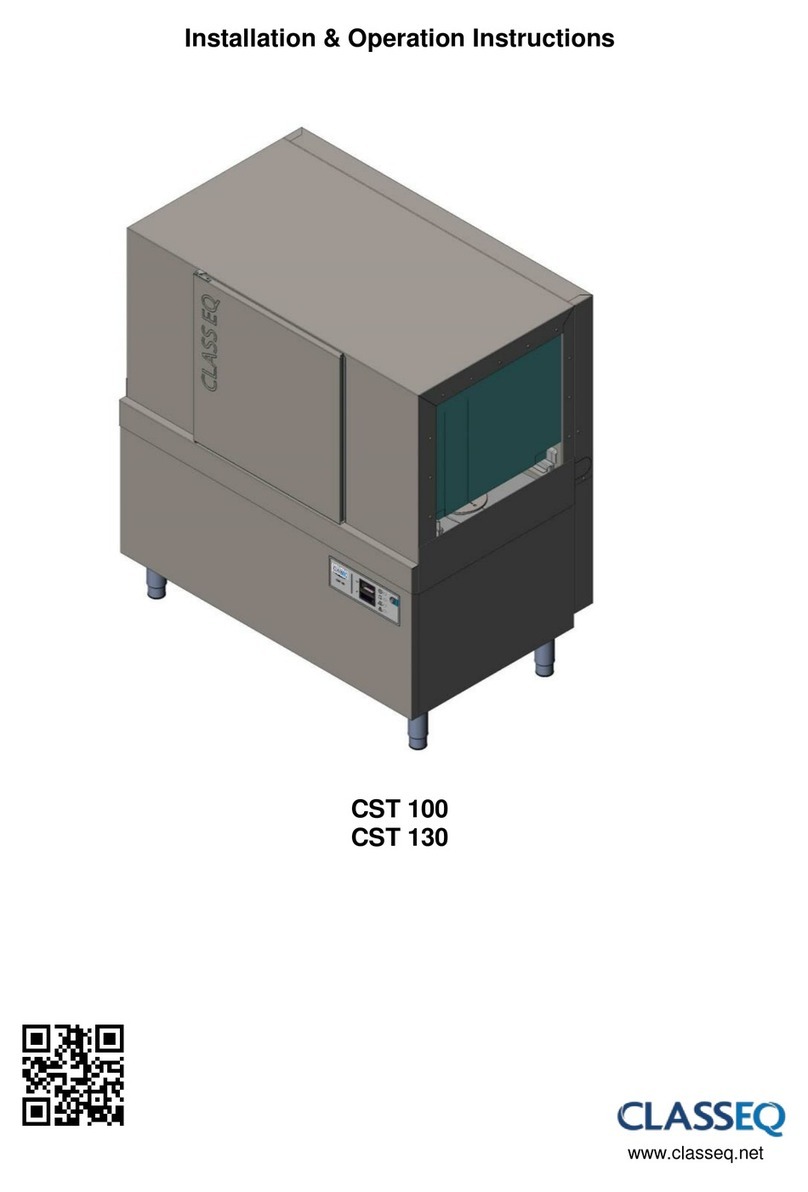
Classeq
Classeq CST 100 Installation instructions
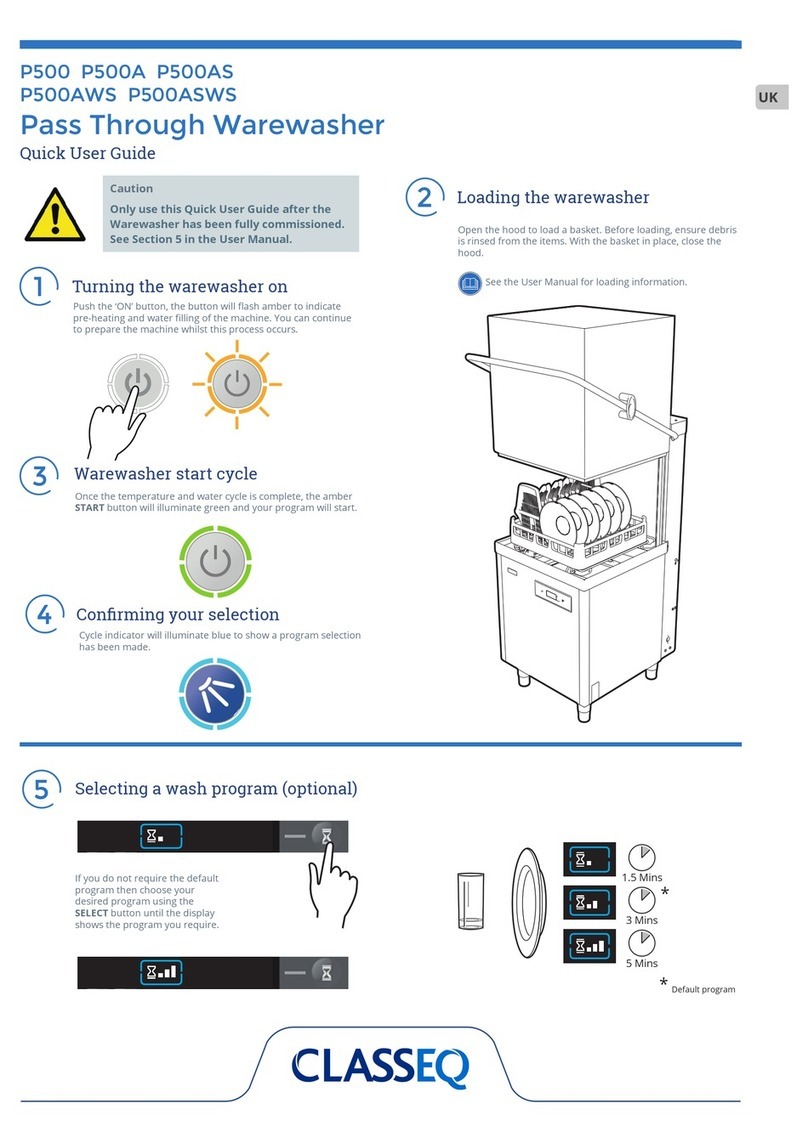
Classeq
Classeq P500 Instruction manual
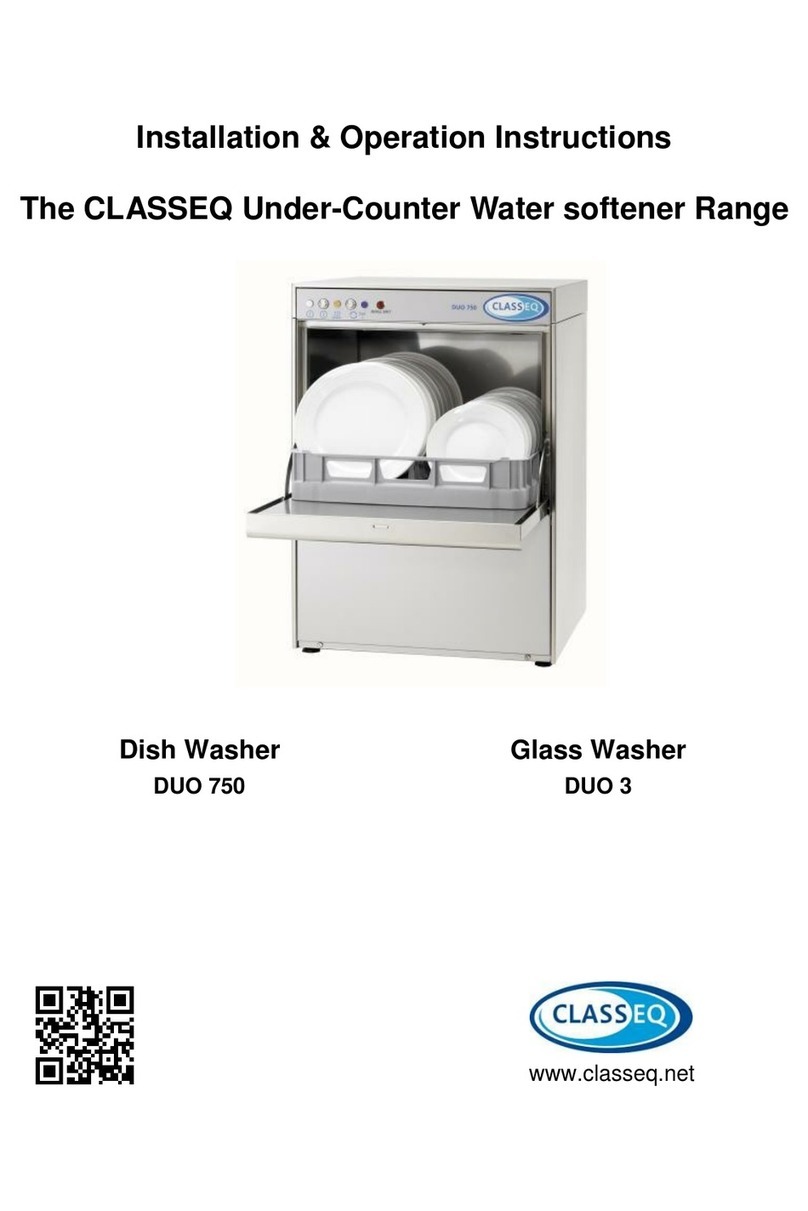
Classeq
Classeq DUO 750 Installation instructions

Classeq
Classeq G 350 User manual
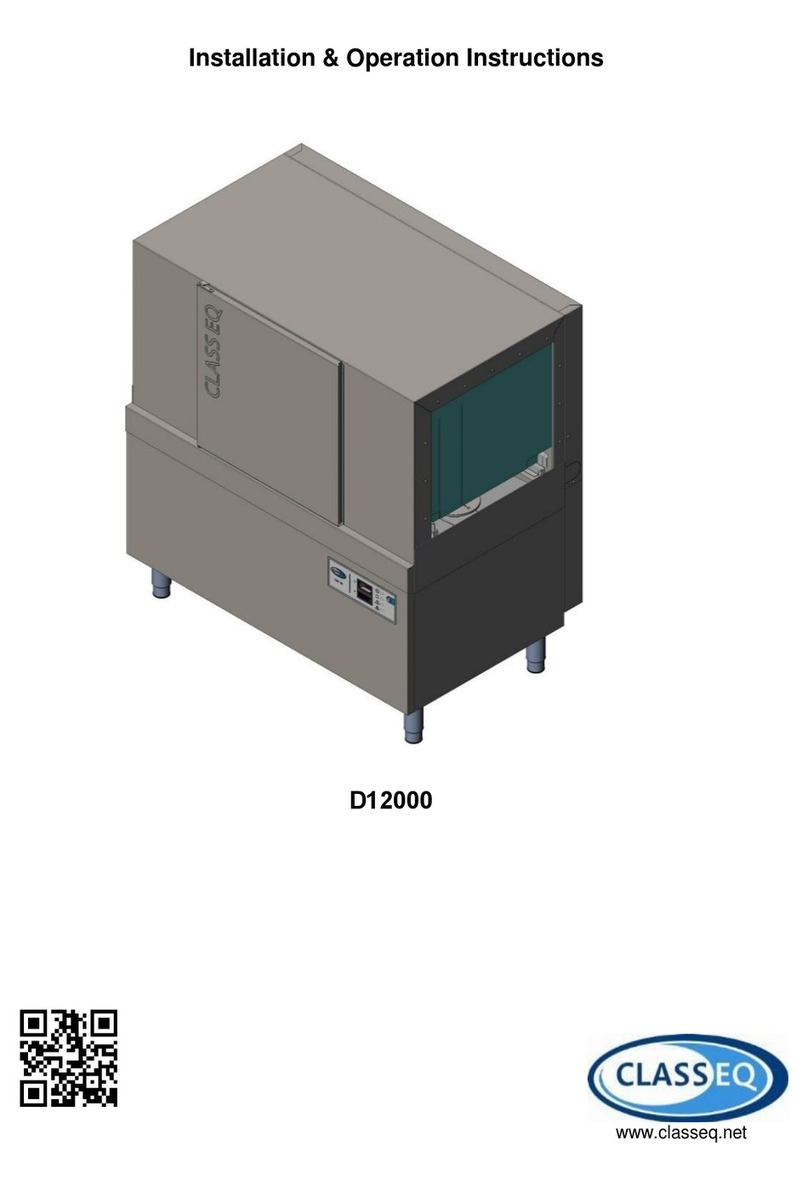
Classeq
Classeq D12000 Installation instructions

Classeq
Classeq C200G Administrator Guide
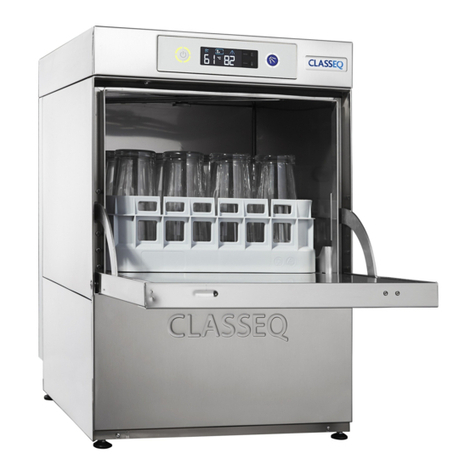
Classeq
Classeq G 350 Quick start guide
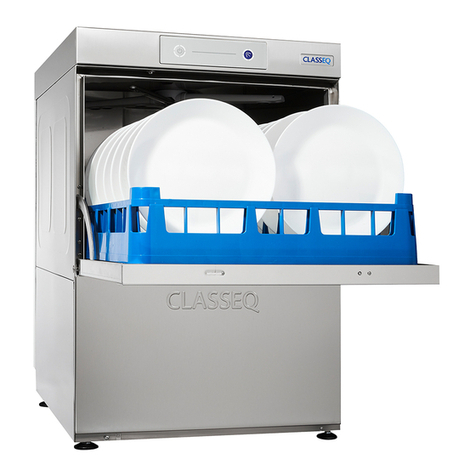
Classeq
Classeq ECO 2 Administrator Guide
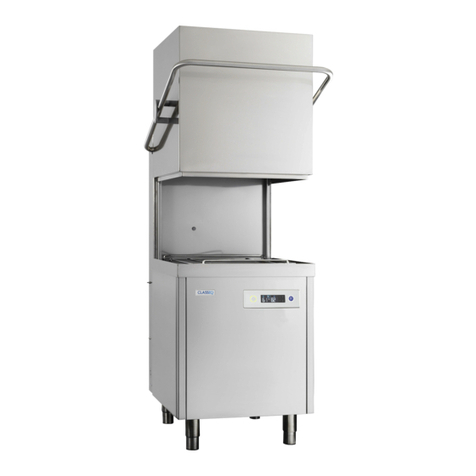
Classeq
Classeq P500AS User manual
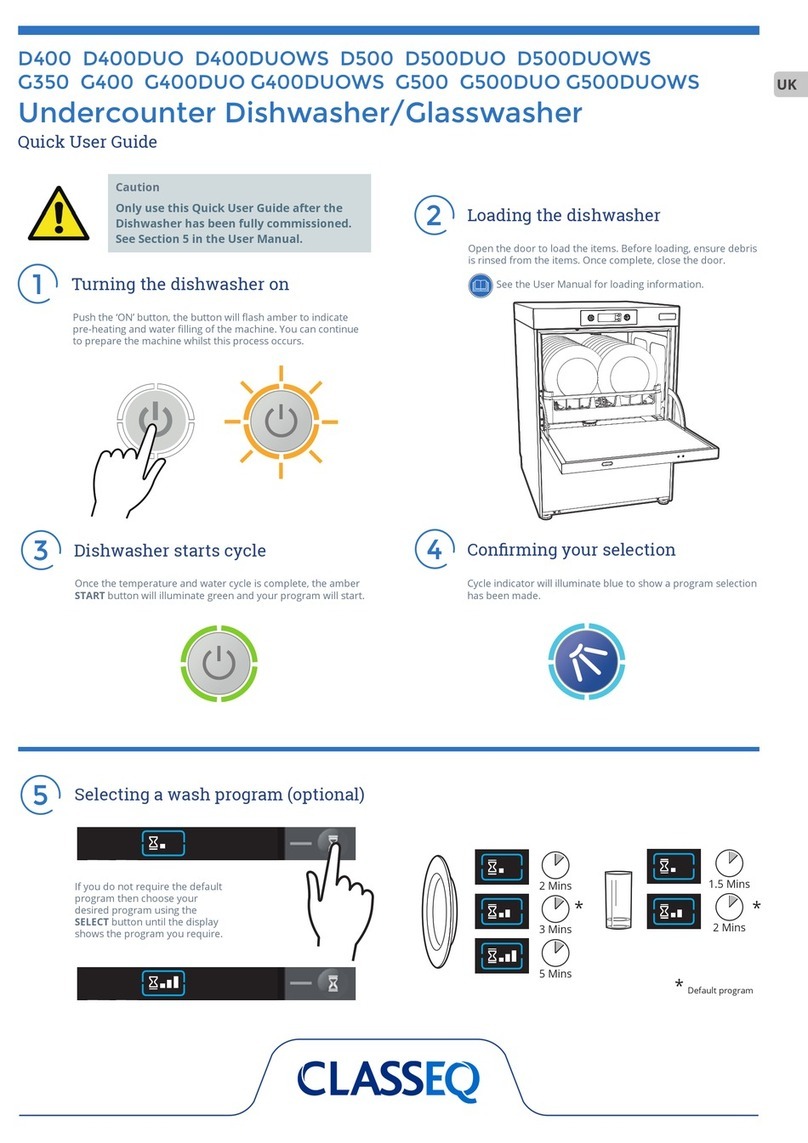
Classeq
Classeq D 400 Instruction manual
